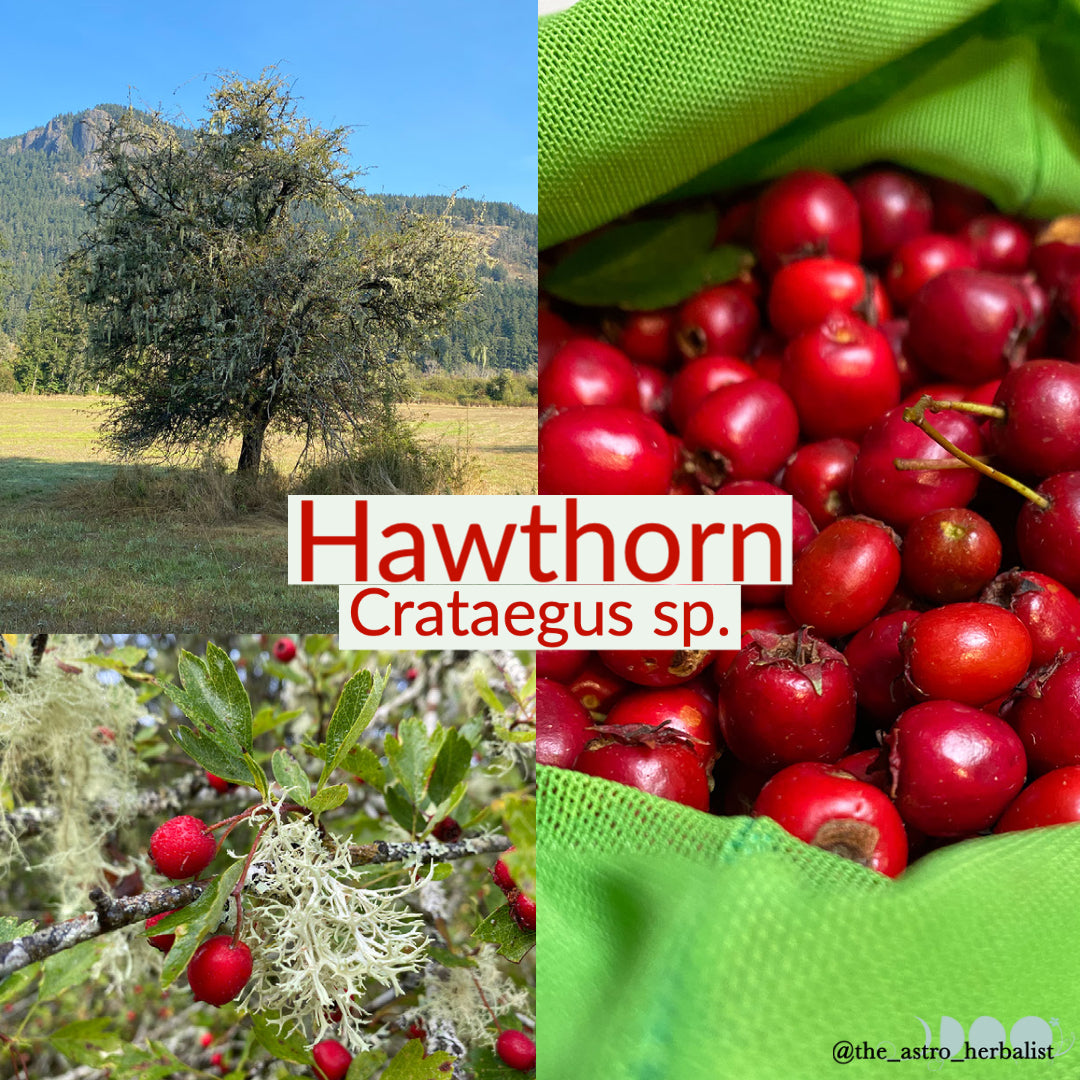Hawthorn (Crataegus spp.) can be found world wide with around 280 different species. There are two main species here in Southern BC, Crataegus douglasii (Black Hawthorn), and Crataegus monogyna (English Hawthorn/One Seed Hawthorn). Douglasii, or MÁT̸ŦEN ILĆ in the local SENĆOŦEN language, is the native species, and monogyna is a non-native invasive species. In Europe, Hawthorn was often used to plant hedgerows between fields and pastures to help contain animals, and there is some evidence that it was brought over by colonisers and used for the same purpose here. Black Hawthorn has been an important traditional wild food source to the Coast Salish peoples, and it is now being threatened by the invasive English Hawthorn.
The main difference between the two species is the berry colour, douglasii having dark purple, or black berries, and monogyna having bright red berries. The two species also have different leaf shapes, monogyna with deeply lobed leaves, and douglasii with only slightly lobed leaves. You often see them growing with an understory of Snowberries (Symphoricarpos albus) whose white berries give a beautiful contrast to monogyna’s bright red ones.
Hawthorns mainly spread by seed, but they also have the ability to propagate through suckers. The berries drop straight to the ground, or are eaten by birds which carry the seeds far and wide. Monogyna can create sharp, dense thickets that are difficult for animals to move through, and compete for light and space with the native plants. They grow very fast in their first 15 years of life, often taking over entire areas of forest and field. Monogyna also has the ability to hybridise with the native douglasii, diluting this species even further.
In Celtic traditions, Hawthorn is one of the sacred trees and is part of the Ogham, the Celtic alphabet, as Huath, representing the letter H. The tree is linked to two major Celtic celebrations, Beltane and Samhain, with the flowers blooming near Beltane, and the berries ready for harvest near Samhain. Hawthorn has also been called the Fairy Tree because they are believed to be a gateway between our world and the fairy world, especially if that tree stands on its own, away from other trees. Often during Beltane celebrations, pieces of cloth are tied to a Hawthorn as an offering to these fairies. Hawthorn trees are revered and also feared. If you cut a Hawthorn down, or damage it in any way, it has been said that you will invoke the wrath of the fairies who inhabit the tree. Stories of kidnapping, injury and curses have been associated with the damaging of a Hawthorn tree. One famous story comes from Downpatrick in North Ireland about the building of a road:
“...The Irish road workers knew the tales and refused to hurt the tree, leaving the entire tree for the English foreman to take care of himself. Not believing the stories, the foreman cut the tree, and as he did, hundreds of little white mice emerged from under the roots. As the mice scattered into the surrounding countryside, the workers believed this to be the fairy guardians of the tree and further refused to work on the road. As the foreman was transporting soil from the spot of the uprooted Hawthorn, a nearby horse became frightened, and ended up crushing the foreman against a wall, injuring him badly and eventually causing him to lose his leg.”
(from https://celticmythology.com/hawthorn-trees-in-celtic-mythology/)
Hawthorn trees provide many useful offerings to humans and animals alike. The flowers are harvested in the spring and are often used to make cordials, and teas. They are also one of the first sources of nectar in the spring for early pollinators. The young leaves can be eaten as a salad green, and the berries are collected in the fall and can be used to make jams, wine and infused honey. Hawthorn thickets create homes for wildlife like birds and small mammals, and the berries can be seen on the trees well into the winter, providing an important food source to the creatures that the thickets house. The wood of the tree is very hard, and was often used to make tool handles and fence posts. Its latin name of Crataegus is derived from the Greek word, “kràtaigos”, which means “strength and robustness”, alluding to the character of the wood.
Medicinally, the berries, flowers and leaves are all used. The leaves and flowers are best gathered together in the spring (late Aries and early Taurus seasons), when the flowers first open and the leaves are young. The berries ripen in the fall (Libra into Scorpio), and are ready to harvest when they easily release from the tree. Since the different parts are ready at different times, I like to make separate tinctures, one of the fresh flowers and leaves in the spring, and one of the fresh berries in the fall, then mix them together so all the medicine the tree has to offer is available in one remedy.
Hawthorn has been used for spasmodic pain, as a sedative, and for diarrhoea, but its main usage is as a heart and circulatory remedy. It is antioxidant, cooling, astringent, and a bit sweet and sour. It is high in flavonoids, with the highest concentration usually found in the flowers. These attributes allow the medicine to ease inflammation, strengthen the heart muscles, and tone and strengthen capillary beds. It is a cardiac tonic, helping to reduce the chances of a heart attack, and it is a specific remedy for palpitations, arrhythmia and an irregular pulse. It also improves the uptake of oxygen by the heart, improves blood flow to the heart, opens the chest to help relieve asthma and tones the heart muscle to improve the efficiency of contractions. It has also been shown to have a normalising effect on cholesterol levels. It is especially beneficial in age-related heart degeneration because it helps to nourish the tissues of the heart by allowing the flow of oxygen and nutrients more easily.
Hawthorn is a slow remedy, best used over the long term, and like many remedies that are also used for food, Hawthorn is very safe to consume in higher amounts for most individuals. However, since it is considered a long-term remedy, lower to moderate doses daily often have more of an impact than higher doses. The standard dose of tincture is 3 - 5 ml, 3 times a day, however results have been seen with as little as 1 drop per dose. If you are taking any form of medication for your heart or circulatory system, it is best to speak with a qualified practitioner to determine whether Hawthorn would be safe to add to your routine.
On a more esoteric level, Hawthorn is used (like many plants with thorns) as a protection herb, as well as to give courage to an individual. It is believed to not only work on the physical heart, but the spiritual and emotional heart as well, helping us to feel more aligned with our true self. Hawthorn opens the heart, allowing any trapped negative feelings like anger or frustration to rise up and out. It is used during times of heartbreak and grief to help give strength and courage to the heart. The flower essence is used to protect and warm the heart, as well as to promote a feeling of comfort with who we are as an individual.
According to Culpeper, Hawthorn is Mars ruled, which makes sense due to its affinity for inflammatory conditions, and its thorns and red berries. However, not all Hawthorn species have red berries, and Hawthorn has such a strong affinity for the heart, it makes more sense to me for it to be ruled by the Sun. The Sun rules the Heart and Mars rules the blood, so they do work together in our body that way. Maybe it is more appropriate to say that Mars and the Sun co-rule Hawthorn, Mars more on the physical side (thorns and red berries), and the Sun on the medicinal side (the strong affinity for the heart).
The energetic qualities of Hawthorn also align with both Sun rulership and Mars rulership. The Sun is evoked when Hawthorn is used to promote comfort and peace with one's true self, our Sun sign being who we are at our core, and when courage is what we are after, that is when we look to Mars, the warrior, and planet of protection.
Sources:
https://fviss.ca/invasive-plant/english-hawthorn
https://www.greenseattle.org ›
https://www.nwcb.wa.gov/images/weeds/English_hawthorn_written_findings.pdf
https://celticmythology.com/hawthorn-trees-in-celtic-mythology/
https://www.evolutionaryherbalism.com/
https://thedruidsgarden.com/2015/10/30/sacred-tree-profile-hawthorn-lore-medicine-magic-and-mystery/
Botany in a Day, by Thomas Elpel
Pacific Northwest Medicinal Plants, by Scott Kloos
The Modern Herbal Dispensatory, by Thomas Easley and Steven Horne
Western Materia Medica, by Terry Willard and Todd Caldecott
The Earthwise Herbal: Volume 1, by Mathew Wood
Culpeper’s Complete Herbal, by Nicholas Culpeper
The Humoral Herbal, by Stephen Taylor

